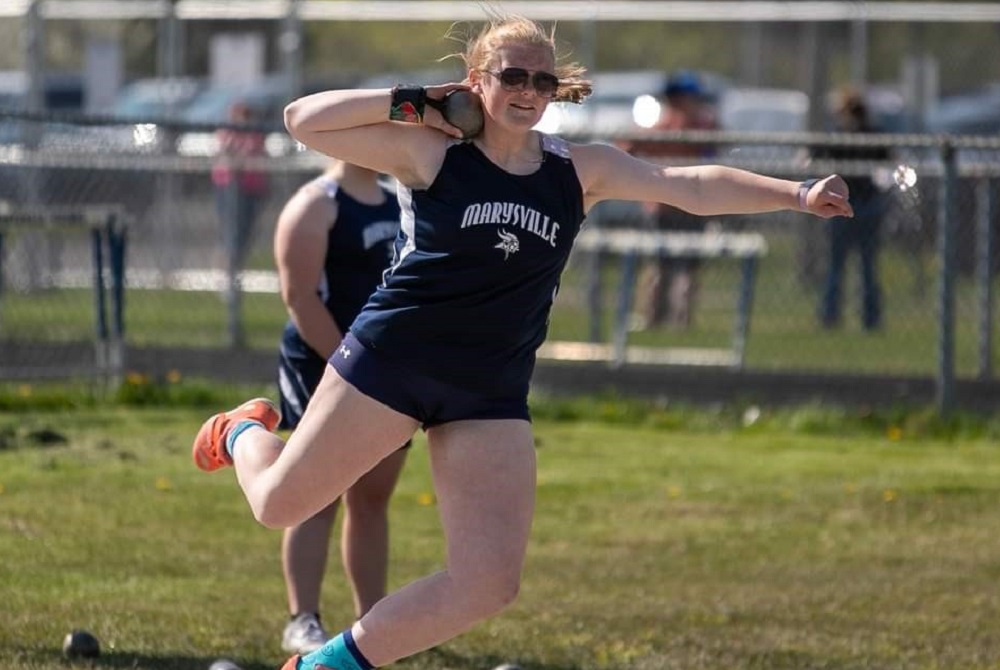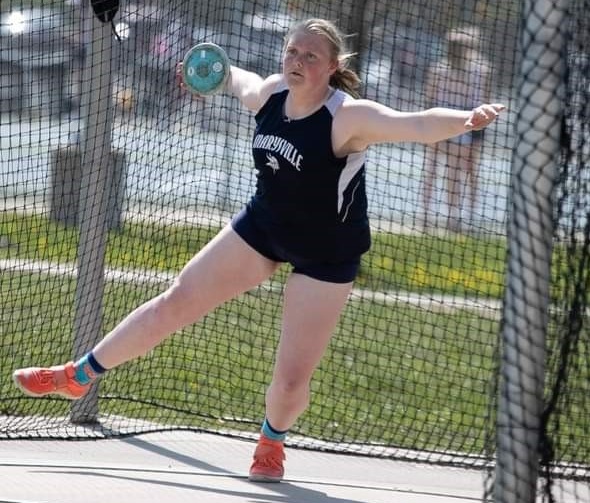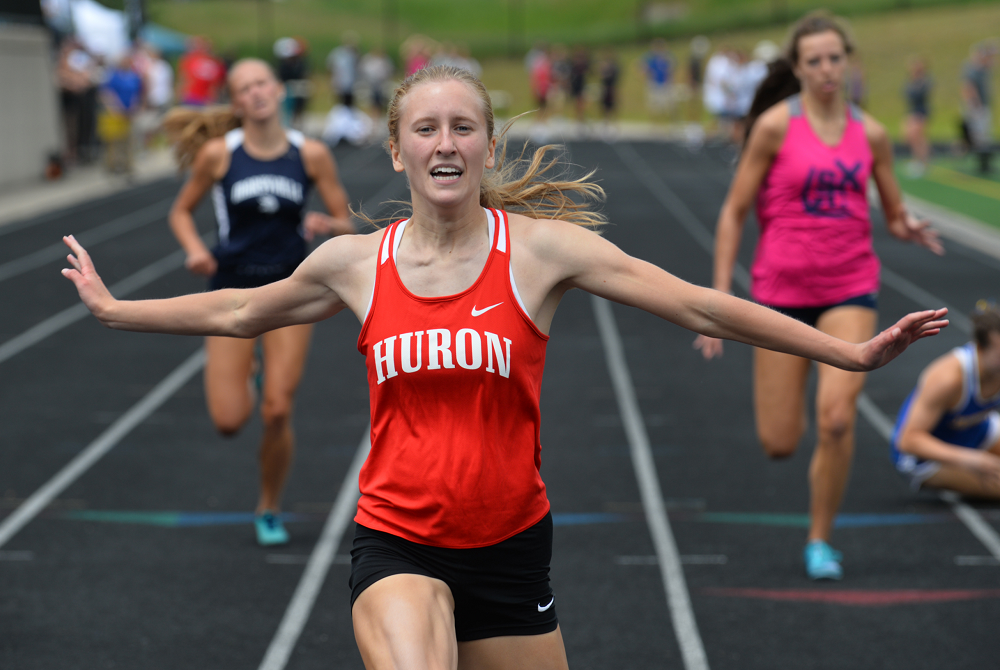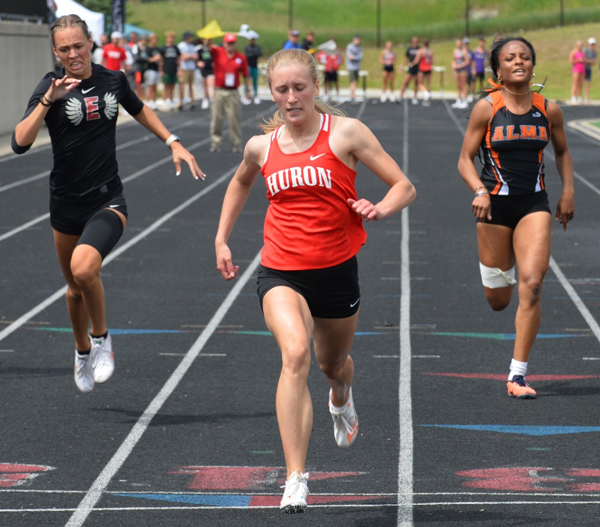
Marysville Thrower Hudson Dancing Into Record Books, Finals Contention
By
Paul Costanzo
Special for MHSAA.com
April 12, 2023
If you see Janae Hudson doing the “Cotton Eye Joe” dance near a shot put or discus pit this spring, don’t be surprised.
 But do pay attention, because a Marysville school record may be about to fall.
But do pay attention, because a Marysville school record may be about to fall.
“I used to get really stressed out before meets, and it would definitely impact my throws,” the Marysville junior said. “I thought that maybe I need a specific routine to not freak me out or anything, and I kind of have it with volleyball, as well. I like to just go off in my own space. When I’m in the hole, I like to kind of just dance around and get all the jitters out before I throw. It’s kind of like a line dance, something I can do in a single space and not bump into other people. I did it last year, and it started to work.”
Hudson, who placed third at the 2022 Lower Peninsula Division 2 Finals in the discus, has already danced and thrown her way into the Marysville record books. She holds the school record in the discus with a throw of 135 feet, 7 inches. Her sights are now set on the shot put record of 40-10, which is about a foot and a half better than her personal best of 39-2¼.
“She’s such a competitor,” Marysville coach Brian Gwisdala said. “She’s already set high expectations for herself. Track is one of those sports where she’s got distances she wants to hit this year. And I think it’s the sign of a mature kid, even though she wants to finish first at states, her big thing right now is she wants that shot put record at the school. She threw 29-2¼ at Saginaw this year. She’s getting there.”
While Hudson showed potential as a freshman, qualifying for the Division 2 Finals and finishing 10th in the shot put, breaking school records certainly wasn’t the expectation at that point.
In fact, when she entered high school, she figured volleyball would be her main focus. While she still plays and is a major contributor for the Vikings volleyball program, throwing has emerged as the sport she wants to pursue collegiately.
 “I was really nervous and timid to actually go to my first track practice,” she said. “But that’s when I fell in love with it. I wasn’t expecting to get this serious with it at the beginning of my freshman year.”
“I was really nervous and timid to actually go to my first track practice,” she said. “But that’s when I fell in love with it. I wasn’t expecting to get this serious with it at the beginning of my freshman year.”
During her freshman year, Hudson began working with throwing coach Michael Hale of Kaizen Throws, and saw immediate results.
She continued to work with Hale through the offseason, and that combined with adding some strength – and a dance routine – helped her take off as a sophomore. In her second season, she added more than two feet to her shot put personal record, and nearly 30 in the discus.
“I think a huge part of it was that she kind of grew into her body,” Gwisdala said. “She’s always been a tall kid, and that coordination and everything caught up to her. I saw it with her in volleyball, too, how much she improved athletically. She really worked hard and put in the time. She throws during the indoor season in the winter. She’s got her private throwing coach that she goes to. All of those factors, and she had the determination and drive to go and do it.”
All of that has put Hudson in a strong position heading into her junior season, not only to further one school record and chase down another, but to improve upon her places at the Division 2 Finals.
Her personal-best discus throw would have tied for first at the 2022 Finals, while her personal best in the shot put would have placed fourth.
“I would love to go to states in both events, and to place first in both would be an ideal situation,” she said. “But if I could finish top three in both, I would walk out happy.”
Helping Hudson chase that ideal situation of winning a Finals title is having watched a teammate do it just two years ago, as Reese Powers won the 400 meters as a junior at the 2021 Division 2 Finals.
“That’s huge,” Gwisdala said. “Just the fact that it was somebody from our school. And it wasn’t someone that necessarily just did one thing, either. Reese and (all-state runner Hannah Fisher) both were multi-sport athletes. The other huge part, and I would say this about Janae right now, too, with Reese was just her work ethic. You would see it every day in practice.”
All of that resonated with Hudson.
“It was a wild moment,” she said. “She’s a junior in high school and can do that; I can do that, too. It would probably mean the world to me.”
 Paul Costanzo served as a sportswriter at The Port Huron Times Herald from 2006-15, including three years as lead sportswriter, and prior to that as sports editor at the Hillsdale Daily News from 2005-06. He can be reached at [email protected] with story ideas for Genesee, Lapeer, St. Clair, Sanilac, Huron, Tuscola, Saginaw, Bay, Arenac, Midland and Gladwin counties.
Paul Costanzo served as a sportswriter at The Port Huron Times Herald from 2006-15, including three years as lead sportswriter, and prior to that as sports editor at the Hillsdale Daily News from 2005-06. He can be reached at [email protected] with story ideas for Genesee, Lapeer, St. Clair, Sanilac, Huron, Tuscola, Saginaw, Bay, Arenac, Midland and Gladwin counties.
PHOTOS (Top) Marysville’s Janae Hudson unwinds while putting the shot during a meet. (Middle) Hudson prepares to let the discus fly. (Photos by Rodney Thomas/Thomas Sports Photography.)

Multi-Sprint Champ Racing to Finish Huron Career Ahead of the Rest Again
By
Keith Dunlap
Special for MHSAA.com
May 25, 2023
NEW BOSTON – If there was one thing Elizabeth Anderson took pride in elementary school, it was simply showing that she could outrun everyone in sight.
 In fact, Anderson has an explanation for all the success she had in those playground races.
In fact, Anderson has an explanation for all the success she had in those playground races.
“Dominance when you are in elementary school,” Anderson quipped. “I don’t think I ever had a nickname. I just think everyone knew I was fast.”
Years later, pretty much everyone who follows track & field in the state of Michigan can attest to that.
A senior for New Boston Huron, Anderson has been faster than most other competitors in the state during her three-year high school career (with her freshman season in 2020 canceled due to COVID-19).
Last year, Anderson won titles at the Lower Peninsula Division 2 Finals in the 200-meter (25.07) and 400-meter (56.28) dashes, and was runner-up in the 100-meter dash (12.23).
Often, top sprinters focus on one or two of those three races. But Anderson is certainly a different breed of sprinter because she does all three.
In fact, she holds school records in all three of those events, and if all that weren’t enough, Anderson is a part of all three sprint relay teams.
“It is hard to give her events off,” said New Boston Huron head girls track coach Danielle Lobato.
Despite the different styles the 100, 200 and 400-meter dashes present, Anderson said there usually isn’t much adjusting when she goes from one of those races to another.
 The strategy is simply, “Let’s beat the other girls to the finish line.”
The strategy is simply, “Let’s beat the other girls to the finish line.”
“I don’t really go into each race changing up how I would run,” she said.
While enjoying and succeeding in all three races, Anderson said she actually does have a favorite among them.
“I would say the 400 is probably my favorite,” she said. “Even though it hurts, it’s satisfying to see how much you can get your time down in the 400 compared to any other race.”
Anderson said she started running track in sixth grade, but really got serious about it during the summer after her sophomore season, when she was invited to run for a local club.
Eventually, that led to her competing over the winter in indoor events.
She lived and breathed track so much that last fall, she decided to not run cross country so she could focus on a weightlifting regimen aimed at developing more leg strength.
“Once I started doing summer track, I realized I wanted to be doing this all the time,” she said.
Lobato said oftentimes in practice, Anderson is a de facto coach, given there is no better person she can think of for the younger runners on the team to learn from.
“I can’t always demonstrate these things I’m trying to teach,” she said. “You get to see it in real life (from Anderson), not in a YouTube video.”
After winning the 100, 200 and 400-meter dashes at her Regional meet last week, Anderson has her sights set on achieving the same trifecta of titles at next Saturday’s Finals in Grand Rapids.
Anderson has signed to run track at Michigan State, but has been plenty motivated to keep producing this spring in her final high school season.
“I’m really looking to defend my titles,” she said. “That is what is really motivating me to keep going. I want to keep in shape for the college season. I don’t want to lose any of the progress I have made. Ultimately, I just love running track.”
And since elementary school, Anderson has loved — and succeeded in — outrunning everyone else to the finish line.
“We knew we were getting something special,” Lobato said of when Anderson arrived in high school. “But you never expect this. All that she has accomplished is amazing.”
 Keith Dunlap has served in Detroit-area sports media for more than two decades, including as a sportswriter at the Oakland Press from 2001-16 primarily covering high school sports but also college and professional teams. His bylines also have appeared in USA Today, the Washington Post, the Detroit Free Press, the Houston Chronicle and the Boston Globe. He served as the administrator for the Oakland Activities Association’s website from 2017-2020. Contact him at [email protected] with story ideas for Oakland, Macomb and Wayne counties
Keith Dunlap has served in Detroit-area sports media for more than two decades, including as a sportswriter at the Oakland Press from 2001-16 primarily covering high school sports but also college and professional teams. His bylines also have appeared in USA Today, the Washington Post, the Detroit Free Press, the Houston Chronicle and the Boston Globe. He served as the administrator for the Oakland Activities Association’s website from 2017-2020. Contact him at [email protected] with story ideas for Oakland, Macomb and Wayne counties
PHOTOS (Top) New Boston Huron's Elizabeth Anderson clears the finish line during last season's LPD2 400 race. (Middle) Anderson, middle, outpaces the field to also win the 200. (Click for more from RunMichigan.com.)

